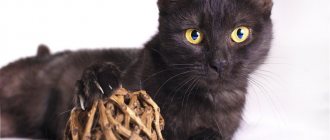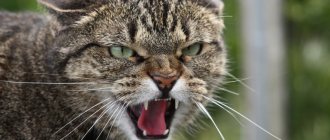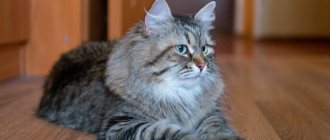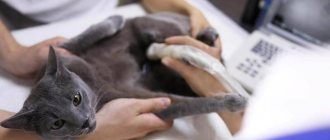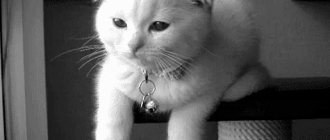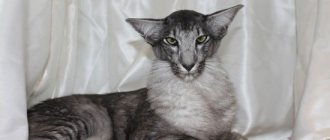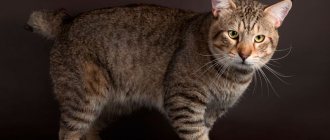The characteristic color with a clear letter “M” on the cat’s forehead is considered the breed standard for the Abyssinian, Egyptian Mau, Singaporean, Somali and Siberian cats. For some varieties of domestic animals, this sign is recognized as a defect, and such kittens are discarded. Mystical fur coloring has given rise to legends that have nothing to do with reality.
How to choose a kitten
Before buying, you need to pay attention to the price, since British ones usually cost an order of magnitude more, but this is not always the case. Much depends on the purity and availability of pedigree, as well as documentary evidence
Three rules
You definitely need to hold the kitten in your arms - the quality and length of the fur are noticeably different, but you can feel this only in comparison.
Make sure that both parents belong to the same breed, that is, British kittens were born from the mating of a British cat with a cat, and also for Scots - both parents are of the same breed. To do this, you can ask for animal documents. Another important sign is the appearance, which is described above, but here too everything can be learned by comparison. The British are massive, they have a wide body, the neck is very short, it may not be visible at all, the ears are only straight
The Scots are more refined and petite, their neck is clearly visible, their paws and tail are thinner, and the expression of their eyes is slightly different. It is important to remember that even if you watch a video of how a British cat differs from a Scottish cat, it is not always so easy to distinguish these two breeds. Scots can have either straight or fold ears, but Britons are born with straight ears only! Those who decide to breed or participate in exhibitions should know that Scottish Folds are marked SFS, Scottish Shorthairs are SSS and SCS
This helps to distinguish them, because if representatives of both breeds are straight-eared, then often even professionals cannot determine the identity of the animal; in this case, only documents, pedigree and a mark in the metric will help.
There are differences between the British and the Scots, but even a professional cannot always notice them. To distinguish these two breeds, it is necessary to compare their appearance, but the most reliable option is to look at the pedigree and documents, especially if representatives of both breeds are straight-eared.
What does the letter "M" mean?
Markings on the fur are elements of a camouflage arsenal from wild relatives.
This color is not always a sign of a purebred breed. You can also find this pattern on an ordinary domestic kitten. Stripes are a sign of ancient origin; they helped the ancestors of pets hide in the bushes. It should be borne in mind that for some animals the letter “M” on the forehead is an undesirable feature, and individuals are rejected from the standard. These breeds include:
- Russian blue. Shorthair, one of the most sought after in the world.
- Burmese. It has an unusual color, thanks to which it is recognizable.
- Siamese. Short-haired, with blue eyes.
- Chartreuse. Another name is Cartesian, originally from France.
- Bombay. Black American, bred in the twentieth century in Kentucky.
- Balinese. Long-haired version of the Siamese.
British advantages
The British breed was developed quite a long time ago. Even the Scots descended from her, with whom the comparison will be made. If you prefer large cats, then a representative of the British breed is suitable. The weight of an adult reaches 6–7 kg.
The Briton is usually calm and tolerates the long absence of his owners well. If there are children in the family for whom the kitten is purchased, then you should not choose a representative of this breed. The entire history of studying the behavior of the British indicates that they are loners. Cats of this breed are especially not prone to active noisy games.
The advantages of the British include:
But do not be mistaken: for all their aristocratic nature, the British do not have unlimited patience and will never become that submissive toy that can be tied in a knot.
Legend of the letter
In the Middle Ages, a cat, especially a black one, could be killed as an “accomplice of the devil.” But the breed with the letter “M” was considered good. It was believed that this was supposedly the seal that the Virgin Mary put on the forehead of a certain cat who warmed the Baby Jesus in the manger on the night of his birth. Since then, the descendants of this individual have been under the protection of the Mother of God. To be fair, it should be said that in the Aramaic language, which Christ spoke, the letter that conveys the sound “m” has a completely different shape. In the Muslim world it is believed that the Prophet Muhammad was partial to these cats.
Is Mary to blame?
A pattern in the form of the letter “M” is currently found on the forehead of cats of various breeds. In the DNA of cats of this color there is a special gene that is responsible for the formation of “Use the freezer”: the director of a dry cleaner gave advice on saving
How exactly does this gene work so that the letter “M” appears? In fact, no alphabet is encoded here. The secret to the appearance of this particular pattern is that the fur on the cat's forehead grows in one direction, perpendicular to the ears, and the darker lines of fur, which appear due to the agouti gene, line up in the same direction. The furs are not necessarily absolutely parallel to each other, and this feature of their growth leads to the appearance of a pattern that reminds you of the letter “M”.
Description of the breed
There are cats with the letter “M” clearly visible on their foreheads. It is often darker than the animal's dominant coat color. This coloring is called “tabby” and is recognized as a necessary component of the breed standard for the following cats:
- Abyssinian. Considered to be the oldest breed, it is believed to have originated in Ethiopia. 4 types of color have been recorded.
- Egyptian Mau. A medium-sized spotted animal.
- Somalia. Genetically descended from the Ethiopian, but long-haired.
- Singaporean. Bred in the 70s of the twentieth century from street cats in Southeast Asia.
- Siberian cat. Most often lives in the wild and is difficult to tame.
Tabby colors come in a variety of colors: mackerel, marbled, spotted and ticked.
Which of the cats, cats, kittens is more expensive, smarter, larger, more affectionate, kinder: British or Scottish?
British and Scottish kittens
The British cat is affectionate, friendly, smart, gets along with all family members, and even other animals, is endowed with great patience, but will only do what it considers necessary. If your family is noisy and has children, a British cat is not suitable; she likes to spend more time alone.
Scottish cats (straight-eared and fold-eared) are calm, flexible, resistant to stress, do not meow unnecessarily, but only when asked to eat, are easily accustomed to order, and will play with children.
The price of British and Scottish cats depends on many factors:
Of course, British cats, due to the antiquity of the breed, will be more expensive.
Preventive measures for skin disease in cats
- Get the vaccine against fungal diseases (Vakderm) on time.
- Don't let your cat go outside. A pet that walks without control may well come into contact with sick animals.
- Support your pet's immunity. For prevention, give medications to strengthen the liver (Hepatovet) and immunity (Immunofan).
- Give the animal only high-quality food, do not overfeed.
- Consult a doctor at the first symptoms of cat skin diseases and begin treatment immediately.
Best names for tabby cats and tomcats
Tabby cats are usually compared to tigers and leopards. However, these nicknames are suitable for particularly large males with well-developed muscles. It is unlikely that such a nickname would be suitable for a fat ginger cat. The name Garfield would be more suitable for this one. And if the main color of the fur coat is close to brown - Bumblebee or Badger.
A tabby kitten could be named Matroskin, but an adult would be more suited to Sailor.
If stripes are reminiscent of a Harlequin costume, why not name a tabby cat by that name?
The gray cat can be called Shadow, the ashen one - Garya, the black-gray cat - Zebra, and the red tabby cat - Cinnamon.
What to name a girl tabby kitten? Cat lovers prefer the names Kitty, Bee (when she grows up, she can be renamed Bee), Iriska (Iris) or Tuchka.
There are many options for nicknames, as well as breeds with striped colors. Which type of animal to choose is up to everyone to decide for themselves. The main thing is to familiarize yourself with the characteristics of the breed in advance, so that later your pet’s habits do not turn out to be an unexpected surprise.
What is the British cat breed: definition, photo
British Shorthair cat breed According to one version, the ancestors of the British cat breed were brought to the British Isles by the ancient Romans at the beginning of our era.
Of course, they didn't look the same as they do now. Over time, the cats got used to the humid and cool climate of the islands and acclimatized. The main purpose of ancient cats was to catch rodents. The first cat show in Great Britain took place in 1871, and the cats were recognized as purebred and began to be called British.
The British Shorthair cat is larger than average in size, girls weigh up to 4 kg, boys - up to 6 kg. They are squat, with a wide chest, well-developed muscles, short thick legs and a thick tail, a massive head, thick cheeks, a small nose, and medium-sized ears. The Briton's coat is thick and short, of different colors and shades, but the classic ones are lilac and blue.
Breed Features:
British cats of these colors can take part in competitions:
The British cat is characterized by good health.
Source
How to choose a kitten
Before buying, you need to pay attention to the price, since British ones usually cost an order of magnitude more, but this is not always the case. Much depends on the purity and availability of pedigree, as well as documentary evidence
Three rules
You definitely need to hold the kitten in your arms - the quality and length of the fur are noticeably different, but you can feel this only in comparison.
Make sure that both parents belong to the same breed, that is, British kittens were born from the mating of a British cat with a cat, and also for Scots - both parents are of the same breed. To do this, you can ask for animal documents. Another important sign is the appearance, which is described above, but here too everything can be learned by comparison. The British are massive, they have a wide body, the neck is very short, it may not be visible at all, the ears are only straight
The Scots are more refined and petite, their neck is clearly visible, their paws and tail are thinner, and the expression of their eyes is slightly different. It is important to remember that even if you watch a video of how a British cat differs from a Scottish cat, it is not always so easy to distinguish these two breeds. Scots can have either straight or fold ears, but Britons are born with straight ears only! Those who decide to breed or participate in exhibitions should know that Scottish Folds are marked SFS, Scottish Shorthairs are SSS and SCS
This helps to distinguish them, because if representatives of both breeds are straight-eared, then often even professionals cannot determine the identity of the animal; in this case, only documents, pedigree and a mark in the metric will help.
There are differences between the British and the Scots, but even a professional cannot always notice them. To distinguish these two breeds, it is necessary to compare their appearance, but the most reliable option is to look at the pedigree and documents, especially if representatives of both breeds are straight-eared.
Diagnostics
A preliminary diagnosis can only be made based on the results of the examination, since the diseases have characteristic clinical signs described above. Additional studies are required to confirm the diagnosis. To exclude the presence of a bacterial or fungal infection, a cytological examination of skin smears is performed. Also, thanks to it, you can see the cells that appear in autoimmune diseases. Autoimmune disease is confirmed using skin histology. Using scrapings, in most cases it is possible to detect skin mites, but the Demodex gatoi mite is very rarely found in scrapings, and this disease is not easy to diagnose. Several methods can be used to diagnose lichen. First, the animal is examined under a fluorescent lamp - this method makes it possible to detect lichen in 50% of cases, since not all types of this infection will glow under the lamp. Then trichoscopy can be performed, thanks to which you can see the hairs destroyed by fungal spores. A more accurate diagnosis is to inoculate hairs in special growth media. Fungi in such environments can grow for a long time, up to 3-4 weeks, but the accuracy of this diagnosis is at least 95%.
Most often, identifying an allergen is not an easy task; there are no special tests for this. First, using scrapings, cultures, etc., it is necessary to exclude all possible differential diagnoses, which will be suggested by the doctor. If allergy remains the most likely diagnosis, the stage of excluding possible allergens will begin. First of all, fleas are excluded, the animal and the room where it lives are treated. A special elimination diet may then be prescribed to rule out food allergies. If the allergen is not identified, a diagnosis of “non-food allergy” or “atopy” is made.
British advantages
The British breed was developed quite a long time ago. Even the Scots descended from her, with whom the comparison will be made. If you prefer large cats, then a representative of the British breed is suitable. The weight of an adult reaches 6–7 kg.
The Briton is usually calm and tolerates the long absence of his owners well. If there are children in the family for whom the kitten is purchased, then you should not choose a representative of this breed. The entire history of studying the behavior of the British indicates that they are loners. Cats of this breed are especially not prone to active noisy games.
The advantages of the British include:
But do not be mistaken: for all their aristocratic nature, the British do not have unlimited patience and will never become that submissive toy that can be tied in a knot.
Common diseases that cause skin lesions
Lichen
Ringworm is a fungus whose spores infect a cat's fur. Usually, infection occurs from another sick animal, and spores can also be brought on clothes and shoes from the street, even if the cat is completely domestic. Ringworm in a cat most often looks like rounded bald patches with scales, crusts and scabs. Localization may be different, depending on which part of the body the fungal spores began to multiply. Ringworm in cats is often found on the face, especially around the nose, ears and around the eyes. You may notice hair loss and characteristic peeling of the skin. The cat most likely will not experience itching or other unpleasant sensations.
Allergy
There are three types of allergies in cats: flea allergy dermatitis, food allergies and non-food allergies. Allergy itself is most often a hereditary disease, and signs in a sick animal appear when any of the allergens enter the body. In most cases they are all visually similar. The first sign of an allergy is itching. With intense itching, the cat will lick itself vigorously, especially in the abdominal area. Can scratch the area around the ears, neck, and chin with its paws. But cats are very secretive animals and will hide their illness from their owner until the last moment. Often signs of itching are detected only during administration. Usually, during the examination, the doctor finds characteristic wounds from the cat’s claws, as well as, as if trimmed, hair in the abdomen and groin area. A cat's tongue is very rough, with many papillae, and by licking itself intensively, the cat literally shave off its own fur.
Also typical of allergies can be lesions called miliary dermatitis. Most often, owners find small crusts on the cat's neck. Similar sores in a cat can appear on the withers, face and other places. Thus, the cat’s skin reacts to the influence of some external factor, in this case an allergen. Another characteristic form of allergy in cats is eosinophilic granuloma complex. This complex manifests itself in three main forms: eosinophilic granuloma, indolent ulcer and eosinophilic plaques.
- Eosinophilic granuloma in cats most often occurs on the chin or border of the lower lip. It looks like a pink or yellowish swelling, soft to the touch, and does not cause obvious discomfort to the cat.
- An indolent ulcer usually affects a cat's upper lip, although it can appear on other areas of the body. It appears as a lesion on the outer edge of the upper lip on one or both sides of the nose. The lesion initially resembles sores with crusts, which grow over time, become clearly defined, and have a red or brown surface. Their surface is concave in the center and raised at the edges.
- Eosinophilic plaques can be found on your cat's abdomen and inner thighs. They are oval or elongated in shape. The color is usually pink, the surface is raised. At first, such lesions are very small, but without treatment they merge and affect large surfaces of the cat’s body.
Scabies mites
There are three main types of skin mites found in cats: demodicosis, notoedrosis and cheyletieliosis. All three types of ticks have their own characteristic clinical signs.
Demodicosis in cats is very rare. The Demodex cati mite is not contagious. Normally, even healthy animals have it. The tick begins to multiply and cause clinical manifestations against the background of the pet’s reduced immunity. It will look like a hairless patch of skin on any part of the cat's body. Most often, such a lesion does not cause concern in the cat. There may be crusts, scales, pimples on the skin, but they may be completely absent. Another type of demodicosis - Demodex gatoi, on the contrary, is very contagious. Cats with this infection experience severe itching and scratch themselves until they bleed.
Hurry up, choose a box and find out what gift awaits you
Discount on pet insurance
Promo code copied to clipboard
Notoedrosis is also a contagious disease, transmitted from a sick cat to a healthy one. Ticks live in the environment for a short time and die quite quickly. Areas affected by mites will look like thickened skin with a lot of crusts and scabs. Scabs on the skin of a cat with notoedrosis can appear all over the body, but more often on the neck, head, chin, and ears. The cat will most likely scratch these areas intensively with its paws. Wool also falls out in these areas. Cheyletieliosis is transmitted between cats, dogs, and rabbits, and is similar in appearance to manifestations of seborrhea sicca. Owners may notice that the cat's skin is very flaky. Usually these peelings are very pronounced, flaky scales that remain throughout the apartment where the cat was. Only a small area of the body may be affected, but most of the skin may be affected.
Acne
Feline acne is not actually a disease. Often it is just a sign that your pet has an allergy. But sometimes it is not possible to establish its cause. Typically, the reason for contacting the clinic is when the owner discovers sores on the cat’s chin. At the beginning of the disease, only small black dots – comedones – can be seen on the chin. Comedones are pores clogged with dirt, sebum and pieces of epithelium. Without treatment, their number increases. Then large red or white-headed pimples and boils appear on the chin.
Autoimmune diseases
There are many different autoimmune skin diseases in cats. The exact cause of their occurrence in pets could not be established, but it is assumed that chronic inflammation and a reaction to medications may be the cause. With such a disease, the skin's own immune cells begin to attack skin cells, which manifests itself in the form of lesions on the body. The most common autoimmune conditions include pemphigus foliaceus. It is characterized by the presence of small pustules on the skin - pimples with a white head. It is quite rare to find such small sores under a cat’s fur. Most often, lesions become noticeable in later stages. You can note the appearance of crusts, scales, and bald patches. Lesions in the area of the ears and nose are typical, and often the only symptom is thickening and crusting on the pads of the cat's paws. Crusts around the claws are also observed in many cases.
Psychogenic itching
Oddly enough, in the presence of stress factors, cats can also intensively lick, scratch or chew themselves. Often with this condition, a cat may have a wound on its tail. The pet inflicts it on himself with his teeth and claws. Stressful factors for cats can be noisy work in the house or with neighbors, rearranging furniture, prolonged absence of owners, and even changing litter for the tray or food.
Which of the cats, cats, kittens is more expensive, smarter, larger, more affectionate, kinder: British or Scottish?
British and Scottish kittens
The British cat is affectionate, friendly, smart, gets along with all family members, and even other animals, is endowed with great patience, but will only do what it considers necessary. If your family is noisy and has children, a British cat is not suitable; she likes to spend more time alone.
Scottish cats (straight-eared and fold-eared) are calm, flexible, resistant to stress, do not meow unnecessarily, but only when asked to eat, are easily accustomed to order, and will play with children.
The price of British and Scottish cats depends on many factors:
Of course, British cats, due to the antiquity of the breed, will be more expensive.
Common colors of tabby cats
The most popular tabby cats include brown, red and gray specimens. The most pronounced owners of brown striped fur are Bengal, Persian, Siberian, Scottish Fold, Oriental Shorthair cats, and Maine Coons.
Exotic shorthair cats deserve special attention:
Despite their short legs, munchkins run very fast.
For your information! Despite their genetic deformity, munchkins are very energetic and agile. Short legs do not prevent them from running fast.
You can’t ignore the ubiquitous red tabby cat. Its coat can be lined with stripes of orange, ginger, marmalade, yellow, buttery, and caramel tones. The reason that causes the red color to mix with black and all its shades, as well as with white, is the “red gene” pheomelanin.
Mr. Cat recommends: the most characteristic breeds with tabby color
There are a great variety of tabby cats, ranging from the most common outbred pets or street (yard) cats. The elite cats bred by breeders in nurseries include, for example, the following tabby-colored cats:
- Australian Mysts;
- Arabian Mau;
- Bengal;
- British Shorthair;
- Egyptian Mau;
- Leohouses;
- Maine Coons;
- Oriental;
- Ocicats;
- Pixie Bobs;
- Savannah;
- Safari;
- Serengeti;
- Siberian;
- Sokoke;
- Toygers;
- Ceylonese;
- Chinese Li-Hua;
- Highlanders;
- Scottish Fold and Straight.
Fold
Straight
The only breed in which the type of color is present even in the name is the Asian Tabby.
Tabby Color Genetics
Tabby patterns are caused by three different gene loci and one modifier.
The Agouti gene, with its two alleles A and a, controls whether or not the Tabby pattern is present. The dominant A expresses the basic Tabby pattern, and the recessive "non-Agouti" or "hypermelanistic" allele indicates its absence. Solid (black or blue) cats have an "a" combination that hides the striped pattern, although traces of it can sometimes be seen (called a "ghost stripe"). This basic pattern, whether classic, tabby, spotted or ticked, is most easily distinguishable in bright light during the early stages of a kitten's development and into adulthood on the tail.
However, the Agouti gene only controls the production of black pigment, so a cat with the O allele (responsible for orange or red color) will still express a tabby pattern. As a result, both red cats and red spots on cat skins will always display striped patterns.
The tabby cat's primary pattern gene is dominant, so it is a cat with the Mc genotype (mc or Mc) - mackerel.
The "Mc" set establishes the basic pinstripe pattern (striped mackerel) that underlies the coat. Mc is the wild type Tabby gene. Classic tabby cats are animals that have two copies of the recessive mc, so they are carriers of the mc/mc allele. This is a recessive mutant (not wild type) mc gene that produces the spotted pattern and appears in the cat as the classic pattern of thick stripes with a bullseye pattern on the sides.
The spotted gene is directly related to the Mc gene, it “breaks” the Tabby stripe lines, turning them into spots. It is also dominant, designated Spotted or Sp (sp or Sp). Sp together with Mc and Agouti make up various combinations - mc and Mc/Mc and A/ a and A/A.
The Ticked tabby pattern is at a different gene locus than the Mackerel and Classic tabby patterns, and is epistatic to (influenced by) other patterns. The dominant Ta/ta mutation masks any other Tabby pattern, creating a striped background or agouti stripe with virtually no lines. If the Ticked tabby pattern gene is present, any other Tabby pattern is masked.
Cats homozygous for the marked allele (Ta/ta) have fewer medallion defects than cats heterozygous for the marked allele. When a cat of this genetic makeup is selectively bred for lack of faults and broad stripes on the hair shaft, the resulting pattern is called shaded.
There are additional alleles and even additional genes influencing Tabby patterns that have also been identified and postulated.
The three most common alleles in order of dominance are Ta, the allele for ticked patterns as in the Abyssinian type, Tm, for tabby mackerel, and the recessive tb for classic.
The Ta allele is dominant over Tm and tb.
A cat with the Ta allele will express a ticked tabby pattern (only with stripes on the paws if there is only one copy and none at all if there are two), and a cat with two tb alleles will express the classic stripe pattern.
The wild type is the mackerel (the stripes look like thin fish bones and can break up into linear markers or spots), the most common variety is the classic striped pattern (wide stripes, curls and spirals of dark color on a pale background, usually with bullseye on the side) and, Perhaps the most famous of the less common tabby cat designs is the “swoosh.”
Classic tabbies are most often found in Iran, England and the lands that were once part of the British and Persian empires. The gene responsible for differentiation pattern formation was named transmembrane Q (Taqpep), which also underlies the coat color of the king cheetah.
King Cheetah
Other pattern modifier genes are responsible for creating different types of spotting, many of which are variations of the basic mackerel or classic pattern. There are also hypothetical factors that influence the timing and frequency of Agouti shifts, affecting the width of its band and the quantity and quality of alternating eumelanin and pheomelanin lines on individual hairs.
There is also a gene, not yet identified but believed to be related to the Agouti gene, in the Chausie breed that produces silvery black fur similar to the Abyssinian. It is assumed that the "gray" phenomenon is inherited from the hybridization of the domestic cat with the House (Felis chaus).
Black Chausie The pigment gene, I/i, is also inhibited.
The dominant allele (I) produces hairs with tips of a different color, which are completely colored only on it and have a white base. This allele appears to interact with other genes to cause varying degrees of coloration, ranging from dark-tipped silver tabby to lightly shaded silver and silver chinchilla. The inhibitor gene interacts with the non-Agouti genotype (I-aa) to produce a color known as smoke. The homozygous recessive genotype combined with the agouti gene (iiA) produces the Tabby's coloration, which can range across the spectrum from a deep-patterned brown tabby to a light yellowish, slightly tinted golden or chinchilla gold. Orange cats with the inhibitor (IO) gene are commonly called "cameos".
Still, the Tabby pattern exists thanks to the Agouti gene. Their stripes have an even distribution of pigment, while the background consists of banded hairs. Tabby cats usually have the following characteristics:
History of Tabby color
Tabby is sometimes mistakenly called a cat breed, but it is only a color variety.
In fact, the tabby pattern occurs in many breeds and is a genetic trait common in the general mixed breed population.
The striped pattern is a natural feature that may be related to the coloration of the direct ancestor of domestic pets, the African wildcat (Felis lybica lybica), which, along with the European wildcat (Felis silvestris silvestris) and the Asian wildcat (Felis lybica ornata), have similar colors .
An in-depth scientific study has shown that five genetic clusters are collected from tabby ancestors of wild cats in different parts of the world.
Since the Tabby pattern is a common wild type, it can be assumed that medieval cats were of this color.
However, some scientists believe that this is not true, at least in England. A little later than the mid-17th century, the naturalist John Aubrey noted that William Laud, Archbishop of Canterbury, was “a great cat lover” and his menagerie “was represented by some Cypriot animals, that is, our tabby pets.” He argued that the common variety of English cats had a white color with some bluish inclusions, which was later practically lost. However, most illustrations or drawings of cats in medieval manuscripts do show them to be tabby.
The English term "tabby" comes from the translation of the French phrase "striped silk taffeta", the root of which is tabis, meaning "rich wet silk".
The word originated in France around the 14th century and is derived from the Arabic term "attabiya", which is a reference to the area in Baghdad, Attabiya (named after Prince Attab of the Umayyad Caliphate) where such silk fabric was first made.
"Tabby" can also be compared to the Spanish word "ataviar", which means "to decorate, put on or wear" and often implies luxurious clothing.
Use of the term "Tabby cat" began in the 1690s and was later shortened to Tabby in 1774.
The concept that "Tabby cat" refers to a female may be a reference to the female proper name Tabitha.
Scottish cats
These animals appeared as a result of a natural genetic mutation. It occurred more than half a century ago in an ordinary white cat named Susie. Subsequently, offspring were obtained from her. One cat from this litter ended up in the family of shepherd William Ross. It was she who became the ancestor of the new breed.
Scottish cats are animals with a strong body, a wide chest and a strong neck. On a round head with a well-developed chin and pronounced whisker pads, there are large eyes and a neat nose. The ears of representatives of this breed can be either straight or downward. The entire body of these animals is covered with a beautiful thick six. As for color, many options are allowed here. Despite this diversity, black, blue and brown Scottish cats are the most common.
The main symptoms and manifestations of skin diseases in cats
Many skin diseases can present with very similar symptoms. You can often see bald patches, wounds, and scabs on the animal’s body. But some diseases have distinctive features, which, when seen, can make a preliminary diagnosis.
- Bald lesions on a cat's body can be found with lichen and demodicosis.
- A large number of scales similar to dandruff are observed when infected with the Cheyletiella mite.
- Wounds with crusts in the scalp area are noted with itching, which is often due to allergies.
- Skin ulcers on a cat's body can be found due to deep skin infection, thermal or chemical burns.
- Black spots on the chin are a sign of feline acne.
- Small crusts on a cat’s skin may indicate miliary dermatitis, which is how the cat’s body reacts to an infection or allergen.
- Pimples with white contents can occur with autoimmune diseases or superficial bacterial infections.
British cats
These animals are distinguished by their strong build with a wide chest and short legs. The round head with well-defined cheekbones has erect ears and large eyes. The entire body of the British is covered with beautiful short fur with a thick undercoat. Representatives of this breed often include tortoiseshell, red, lilac, cream, black and dark brown cats.
The British are very affectionate and clean animals that quickly get used to their owner. At the same time, they calmly tolerate short separation from the owner. These calm, balanced cats do not require complex care. They are not picky when it comes to food, and happily eat both industrial and natural food.
Source
